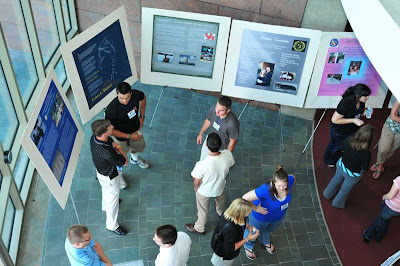Twenty-nine advanced undergraduate and early graduate students traveled from all over the United States to participate in the NASA Student Airborne Research Program (SARP) at the University of California Irvine on Sunday. With the exception of one delayed flight, all travels went off without a hitch. For some, this was their first trip to California, while others came from only a few miles away.
After checking in to the campus housing at UCI, (where we were surrounded by beautiful purple Jacaranda trees in full bloom), everyone unpacked, met their roommate, and relaxed in their rooms for a bit. After months of communicating only over email, it was wonderful to finally meet face to face.

SARP introductory poster session
At 6:30PM on Sunday June 19th, SARP 2011 officially kicked off with the icebreaker/poster session. All 29 SARPian’s prepared and submitted posters with information on their academic backgrounds, research interests, and hobbies. These posters were printed out and displayed in the atrium of the Natural Sciences II building on the UCI campus. SARP participants got to know each other and mingled with NASA scientists and administrators, SARP faculty, mentors, NSERC staff.

SARP students talk to Dr. Jack Kaye, Associate Director for Research in the Earth Science Division at NASA Headquarters
SARP introductory lectures started bright and early Monday morning. We heard from NASA scientists and administrators about NASA’s Earth science research and the Airborne Science Program. Video and powerpoints of all lectures are posted here: http://www.nserc.und.edu/learning/SARPmm.html?2011
Background lectures from university faculty and NASA scientists and administrators will continue through Wednesday (see the schedule here: http://www.nserc.und.edu/learning/sarpSched2011.html). On Wednesday afternoon the students will split into three groups based on their interests (informally called the Air, Land, and Ocean groups). The Air group, lead by Dr. Donald Blake of UC Irvine (with mentor Julie Lee), will study pollution in the Los Angeles basin. The Land group, led by Dr. Susan Ustin of UC Davis (with mentor Shawn Kefauver) will study evapotranspiration from orchards in the California Central Valley. Finally, the Ocean group, led by Dr. Raphael Kudela, will study the distribution and abundance of giant kelp in the Santa Barbara Channel.
Next week all groups will get to fly on the NASA DC-8, departing from the NASA Dryden Aircraft Operations Facility in Palmdale. During the flights, the aircraft will fly north over the San Joaquin Valley over almond orchards, fly over the Santa Barbara Channel to study giant kelp beds, and fly over water treatment plants in Los Angeles Basin to study air pollution.
We are all very excited for the upcoming flights and trip to Palmdale on Thursday!



















